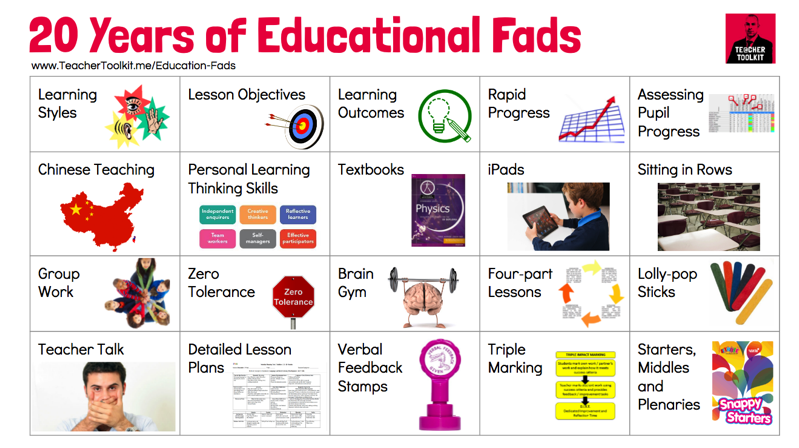Note: this is just over the last 20 years, what’s more all the fads that came before (including Dewey’s revolution and the “New Math” I lived through in the 1960s).

Educators are obsessed with innovation, while ignoring the tried and true, writes Mike Schmoker inEducation Week.
For example, “ongoing monitoring and adjustments to teaching, informed by feedback, may have more impact on learning than any other instructional factor,” he writes. In Teach Like a Champion, Doug Lemov “identifies ‘checking for understanding’ as the pivotal element in an effective lesson.”
I know teachers in two different schools in the same district whose adoption of these methods contributed to enormous one-year, whole-school gains on their state writing exam. . . . their successes were entirely ignored. To our astonishment, their respective school leaders opted to pursue a string of popular—but weak or unproven—innovations, including SmartBoard training and standards-based grading.
New York City’s New Dorp High School was at risk of closure until the principal “decided to go all in on exceedingly traditional instruction in reading, public speaking, and writing” in every subject, writes Schmoker.
The school’s dramatic turnaround was based on instructional “fundamentals that schools have devalued or forgotten,” Peg Tyre wrote in a 2012Atlanticarticle. New Dorp’s program “would not be unfamiliar to nuns who taught in Catholic schools circa 1950.”
“A coherent curriculum—if implemented—has more impact on learning than any other in-school factor,” writes Schmoker. He cites an Arizona school that made rapid gains in math by “having teams of teachers map out, for the first time, what they would teach in each math course, by grading period.”
Yet schools ignore effective, proven practices in favor of “innovations like the flipped classroom, student-centered learning spaces, teaching with mobile apps, gamification, or the now-ubiquitous variations on personalized learning,” Schmoker complains. Fads rule.
Via Joanne